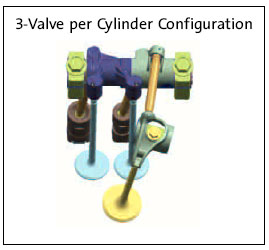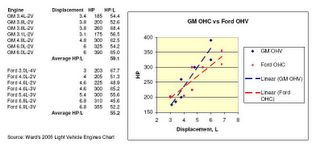Staying with OHVs makes good business sense for GM because the designs and tooling are mature. The enthusiast community, and the automotive press both tend to be hard on the low-end pushrod engines, describing them as "buzzy" and "low tech". However, does the average consumer care? Does your father-in-law the pediatrician know if he has an OHV or DOHC engine in his car? Does your mother-in-law know? If someone is buying a car as an appliance, they may not even care if they are buying an I4 or a V6 (see: Toyota Camry). Many people just want a reliable car at a good price, and won't care about a pushrod design. Some of them might even enjoy the throaty roar.
GM's pushrods are not all primitive, and are getting more advanced, picking up many of the high-tech features. Cylinder de-activation is relatively simple and cheap with the OHV architecture--bleed oil pressure from valve lifters using a solenoid valve. Cylinder deactivation on a OHC design requires some complicated mechanics and electronics, such as BMW's throttle-less Valvetronic engine. The added complexity adds cost and reduces reliability. (Anyone seen a valve de-activation system from Ford yet?)
BMW's Valvetronic valvetrain, courtesy of bmwworld.com
In a recent issue of Automotive Engineering, SAE's monthly glossy, there were some diagrams of a new GM engine design. It has a single cam OHV system which adds a 3rd valve per cylinder by using a horizontal pushrod, which connects to a pivot . You can download a brochure from GM here.

Courtesy of GM.com
A few years ago GM showed the XV8 concept--a twin cam OHV engine. This design supports 3 valves per cylinder and variable cam phasing. The second cam rides over the lower cam, and is driven by a slave chain.
GM's XV8 engine, courtesy of Carcraft.com
GM squeezes some pretty good torque and fuel economy numbers from their engines. Nothing wrong with that. Here is a chart I threw together that shows the distribution of specific power (HP/L) for GM's OHV engines, vs. a sampling of Ford's OHV engines. GM actualy does a little better, in terms of HP/L, with its OHV designs. The data came from Ward's excellent 2005 Light Vehicle Engines chart.

(click for full size version)
GM also puts electronic throttle control on its pushrods--not exactly primtive.
Other advantages: pushrod engines can be made light, like OHCs, using aluminum and magnesium. Pushrod engines don't need long timing belts or chains. They are not as tall as OHC designs, allowing for a lower center of mass, or a more wedge shaped vehicle profile.
The 300C with HEMI is a pushrod, and it is the media darling. And I don't hear many people howling about the Corvette having a pushrod engine.
0 Response to "The Redemption of the Pushrod?"
Post a Comment
Thank you for visitting here. Please left your comment in comment-box below.